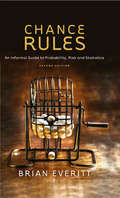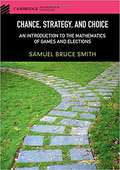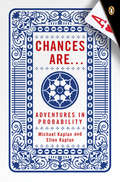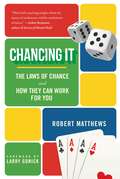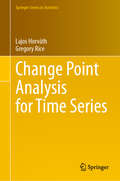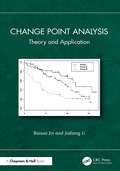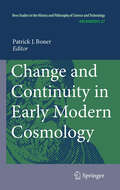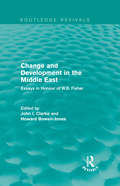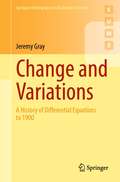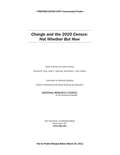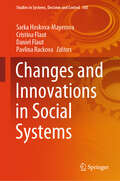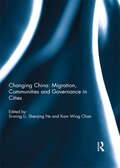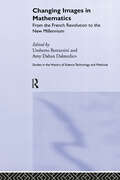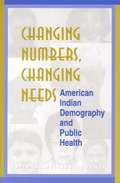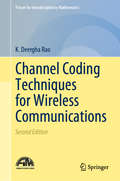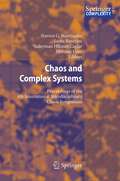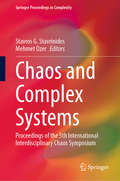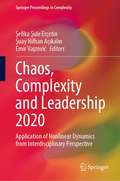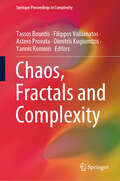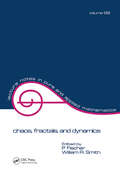- Table View
- List View
Chance Rules: An Informal Guide to Probability, Risk and Statistics
by Brian EverittChance continues to govern our lives in the 21st Century. From the genes we inherit and the environment into which we are born, to the lottery ticket we buy at the local store, much of life is a gamble. In business, education, travel, health, and marriage, we take chances in the hope of obtaining something better. Chance colors our lives with uncertainty, and so it is important to examine it and try to understand about how it operates in a number of different circumstances. Such understanding becomes simpler if we take some time to learn a little about probability, since probability is the natural language of uncertainty. This second edition of Chance Rules again recounts the story of chance through history and the various ways it impacts on our lives. Here you can read about the earliest gamblers who thought that the fall of the dice was controlled by the gods, as well as the modern geneticist and quantum theory researcher trying to integrate aspects of probability into their chosen speciality. Example included in the first addition such as the infamous Monty Hall problem, tossing coins, coincidences, horse racing, birthdays and babies remain, often with an expanded discussion, in this edition. Additional material in the second edition includes, a probabilistic explanation of why things were better when you were younger, consideration of whether you can use probability to prove the existence of God, how long you may have to wait to win the lottery, some court room dramas, predicting the future, and how evolution scores over creationism. Chance Rules lets you learn about probability without complex mathematics.
Chance, Strategy, and Choice
by Samuel Bruce SmithGames and elections are fundamental activities in society with applications in economics, political science, and sociology. These topics offer familiar, current, and lively subjects for a course in mathematics. This classroom-tested textbook, primarily intended for a general education course in game theory at the freshman or sophomore level, provides an elementary treatment of games and elections. Starting with basics such as gambling, zero-sum and combinatorial games, Nash equilibria, social dilemmas, and fairness and impossibility theorems for elections, the text then goes further into the theory with accessible proofs of advanced topics such as the Sprague–Grundy theorem and Arrow's impossibility theorem. • Uses an integrative approach to probability, game, and social choice theory • Provides a gentle introduction to the logic of mathematical proof, thus equipping readers with the necessary tools for further mathematical studies • Contains numerous exercises and examples of varying levels of difficulty • Requires only a high school mathematical background.
Chances Are
by Michael Kaplan Ellen KaplanA compelling journey through history, mathematics, and philosophy, charting humanity's struggle against randomness Our lives are played out in the arena of chance. However little we recognize it in our day-to-day existence, we are always riding the odds, seeking out certainty but settling--reluctantly--for likelihood, building our beliefs on the shadowy props of probability. Chances Are is the story of man's millennia-long search for the tools to manage the recurrent but unpredictable--to help us prevent, or at least mitigate, the seemingly random blows of disaster, disease, and injustice. In these pages, we meet the brilliant individuals who developed the first abstract formulations of probability, as well as the intrepid visionaries who recognized their practical applications--from gamblers to military strategists to meteorologists to medical researchers, from blackjack to our own mortality.
Chancing It: The Laws of Chance and How They Can Work for You
by Robert MatthewsMake your own luck by understanding probabilityOver the years, some very smart people have thought they understood the rules of chance?only to fail dismally. Whether you call it probability, risk, or uncertainty, the workings of chance often defy common sense. Fortunately, advances in math and science have revealed the laws of chance, and understanding those laws can help in your everyday life.In Chancing It, award-winning scientist and writer Robert Matthews shows how to understand the laws of probability and use them to your advantage. He gives you access to some of the most potent intellectual tools ever developed and explains how to use them to guide your judgments and decisions. By the end of the book, you will know:How to understand and even predict coincidencesWhen an insurance policy is worth havingWhy “expert” predictions are often misleadingHow to tell when a scientific claim is a breakthrough or baloneyWhen it makes sense to place a bet on anything from sports to stock marketsA groundbreaking introduction to the power of probability, Chancing It will sharpen your decision-making and maximize your luck.
Change Is the Only Constant: The Wisdom of Calculus in a Madcap World
by Ben OrlinThe next book from Ben Orlin, the popular math blogger and author of the underground bestseller Math With Bad Drawings. Change Is The Only Constant is an engaging and eloquent exploration of the intersection between calculus and daily life, complete with Orlin's sly humor and wonderfully bad drawings. Change is the Only Constant is an engaging and eloquent exploration of the intersection between calculus and daily life, complete with Orlin's sly humor and memorably bad drawings. By spinning 28 engaging mathematical tales, Orlin shows us that calculus is simply another language to express the very things we humans grapple with every day -- love, risk, time, and most importantly, change. Divided into two parts, "Moments" and "Eternities," and drawing on everyone from Sherlock Holmes to Mark Twain to David Foster Wallace, Change is the Only Constant unearths connections between calculus, art, literature, and a beloved dog named Elvis. This is not just math for math's sake; it's math for the sake of becoming a wiser and more thoughtful human.
Change Point Analysis for Time Series (Springer Series in Statistics)
by Lajos Horváth Gregory RiceThis volume provides a comprehensive survey that covers various modern methods used for detecting and estimating change points in time series and their models. The book primarily focuses on asymptotic theory and practical applications of change point analysis. The methods discussed in the book go beyond the traditional change point methods for univariate and multivariate series. It also explores techniques for handling heteroscedastic series, high-dimensional series, and functional data. While the primary emphasis is on retrospective change point analysis, the book also presents sequential "on-line" methods for detecting change points in real-time scenarios. Each chapter in the book includes multiple data examples that illustrate the practical application of the developed results. These examples cover diverse fields such as economics, finance, environmental studies, and health data analysis. To reinforce the understanding of the material, each chapter concludes with several exercises.Additionally, the book provides a discussion of background literature, allowing readers to explore further resources for in-depth knowledge on specific topics. Overall, "Change Point Analysis for Time Series" offers a broad and informative overview of modern methods in change point analysis, making it a valuable resource for researchers, practitioners, and students interested in analyzing and modeling time series data.
Change Point Analysis: Theory and Application
by Jialiang Li Baisuo JinChange point analysis is a crucial statistical technique for detecting structural breaks within datasets, applicable in diverse fields such as finance and weather forecasting. The authors of this book aim to consolidate recent advancements and broaden the scope beyond traditional time series applications to include biostatistics, longitudinal data analysis, high-dimensional data, and network analysis.The book introduces foundational concepts with practical data examples from literature, alongside discussions of related machine learning topics. Subsequent chapters focus on mathematical tools for single- and multiple-change point detection along with statistical inference issues, which provide rigorous proofs to enhance understanding but assume readers have foundational knowledge in graduate-level probability and statistics. The book also expands the discussion into threshold regression frameworks linked to subgroup identification in modern statistical learning and apply change point analysis to functional data and dynamic networks—areas not comprehensively covered elsewhere.Key Features: Comprehensive Coverage of Diverse Applications: This book expands the scope of change point analysis to include biostatistics, longitudinal data, high-dimensional data, and network analysis. This broad applicability makes it a valuable resource for researchers and students across various disciplines Integration of Theory and Practice: The book balances rigorous mathematical theory with practical applications by providing extensive computational examples using R. Each chapter features real-world data illustrations and discussions of relevant machine learning topics, ensuring that readers can see the relevance of theoretical concepts in applied settings Accessibility for Students: The content is designed with graduate-level students in mind, providing clear explanations and structured guidance through complex mathematical tools. Rigorous proofs are included to facilitate understanding without overwhelming readers with overly advanced theories early on The book incorporates computational results using R, showcasing various packages tailored for specific methods or problem domains while providing references for further exploration. By offering a selection of widely adopted methodologies relevant in scientific research as well as business contexts, this text aims to equip junior researchers with essential tools needed for their work in change point analysis.
Change and Continuity in Early Modern Cosmology (Archimedes #27)
by Patrick BonnerViewed as a flashpoint of the Scientific Revolution, early modern astronomy witnessed a virtual explosion of ideas about the nature and structure of the world. This study explores these theories in a variety of intellectual settings, challenging our view of modern science as a straightforward successor to Aristotelian natural philosophy. It shows how astronomers dealt with celestial novelties by deploying old ideas in new ways and identifying more subtle notions of cosmic rationality. Beginning with the celestial spheres of Peurbach and ending with the evolutionary implications of the new star Mira Ceti, it surveys a pivotal phase in our understanding of the universe as a place of constant change that confirmed deeper patterns of cosmic order and stability.
Change and Development in the Middle East: Essays in honour of W.B. Fisher (Routledge Revivals)
by John I. Clarke and Howard Bowen-JonesThe Middle East is a region of great traditional diversity, which has been characterized by immense political, social and economic changes, still developing over thirty years after the title’s original publication. A group of oil-rich countries have achieved great political significance and some of the highest per capita incomes in the world. Much modern development has been spatially polarized, accentuating the concentrations of rapidly growing populations and posing severe problems for planners. Cultivation and pastoralism, the main traditional activities, have often suffered from neglect and insufficient investment, and both require re-evaluation. These are the issues addressed by this volume, first published in 1981, which contains a series of overviews and case studies written by present or former members of staff and research students of the Department of Geography in the University of Durham in honour of W.B. Fisher. Change and Development in the Middle East provides an interesting and relevant geographical and demographic analysis of this diverse and volatile region.
Change and Variations: A History of Differential Equations to 1900 (Springer Undergraduate Mathematics Series)
by Jeremy GrayThis book presents a history of differential equations, both ordinary and partial, as well as the calculus of variations, from the origins of the subjects to around 1900. Topics treated include the wave equation in the hands of d’Alembert and Euler; Fourier’s solutions to the heat equation and the contribution of Kovalevskaya; the work of Euler, Gauss, Kummer, Riemann, and Poincaré on the hypergeometric equation; Green’s functions, the Dirichlet principle, and Schwarz’s solution of the Dirichlet problem; minimal surfaces; the telegraphists’ equation and Thomson’s successful design of the trans-Atlantic cable; Riemann’s paper on shock waves; the geometrical interpretation of mechanics; and aspects of the study of the calculus of variations from the problems of the catenary and the brachistochrone to attempts at a rigorous theory by Weierstrass, Kneser, and Hilbert. Three final chapters look at how the theory of partial differential equations stood around 1900, as they were treated by Picard and Hadamard. There are also extensive, new translations of original papers by Cauchy, Riemann, Schwarz, Darboux, and Picard. The first book to cover the history of differential equations and the calculus of variations in such breadth and detail, it will appeal to anyone with an interest in the field. Beyond secondary school mathematics and physics, a course in mathematical analysis is the only prerequisite to fully appreciate its contents. Based on a course for third-year university students, the book contains numerous historical and mathematical exercises, offers extensive advice to the student on how to write essays, and can easily be used in whole or in part as a course in the history of mathematics. Several appendices help make the book self-contained and suitable for self-study.
Change and the 2020 Census: Not Whether But How
by The National Academy of SciencesSponsored by the Census Bureau and charged to evaluate the 2010 U. S. census with an eye toward suggesting research and development for the 2020 census, the Panel to Review the 2010 Census uses this first interim report to suggest general priorities for 2020 research. <P><P>Although the Census Bureau has taken some useful organizational and administrative steps to prepare for 2020, the panel offers three core recommendations, and suggests the Census Bureau take and assertive, aggressive approach to 2020 planning rather than casting possibilities purely as hypothetical. <P><P>The first recommendation on research and development suggests four broad topic areas for research early in the decade. Second, the report suggest that the Bureau take an aggressive, assertive posture toward research in these priority areas. Third, it identifies the setting of bold goals as essential to underscoring the need for serious reengineering and building commitment to change.
Change-Point Analysis in Nonstationary Stochastic Models
by Boris BrodskyThis book covers the development of methods for detection and estimation of changes in complex systems. These systems are generally described by nonstationary stochastic models, which comprise both static and dynamic regimes, linear and nonlinear dynamics, and constant and time-variant structures of such systems. It covers both retrospective and sequential problems, particularly theoretical methods of optimal detection. Such methods are constructed and their characteristics are analyzed both theoretically and experimentally. Suitable for researchers working in change-point analysis and stochastic modelling, the book includes theoretical details combined with computer simulations and practical applications. Its rigorous approach will be appreciated by those looking to delve into the details of the methods, as well as those looking to apply them.
Changes and Innovations in Social Systems (Studies in Systems, Decision and Control #505)
by Cristina Flaut Daniel Flaut Sarka Hoskova-Mayerova Pavlina RackovaThis book presents challenges and innovations in social problems over the centuries. By their nature, human beings are innovative and continuously adapted to appeared changes over the time. From this point of view, human history can be considered as the story of all changes and innovations which have drastically influenced our way of life. Changes and innovations are normal things in the way of adaptation and are necessary conditions for survival along the time. Changes and innovations are hard and long-term processes. Any progress in history is the result of changes and innovations. To innovate, changes are required: in the culture, in the education, in the way of working, in the way of think, etc. In the same time, innovations imply changes, and changes usually generate reactions. Innovations are always oriented to the future and, in turn, imply changes. From here, the race of evolution was born. Changes require effort, generate resistance but, in the same time, increase performance in almost all domains, and increase vision and leadership; therefore, the progress is obtained. To grew up as a field and provide changes, innovations need to present its theoretical foundations which make sense of the domains on which they are applied. To emphasize the above aspects, the proposed book presents some aspects regarding, but not only limited, to: computer science (new theoretical and practical applications); mathematics (mathematical models, all mathematical results which can improve or are inspired from another known results, some aspects regarding history of mathematics, etc.); education, etc. The chapters of the book present the state of arts of the chosen subjects, from its beginning, its developments, and its applications, by emphasizing the connection with the application or model that the authors have chosen for the presentation.
Changes in Work and Family Life in Japan Under COVID-19 (SpringerBriefs in Population Studies)
by Shigeki Matsuda Hirohisa TakenoshitaThis book describes how the COVID-19 pandemic has affected the way of work, the division of household labor, and family formation in Japan. One of the characteristics of Japanese employment practices is a stable employer–employment relationship and seniority-based wage system. In return, long working hours, especially for men who are called “salarymen” (salaried workers, or “company men”), are required. The pandemic has led to an expansion of telework and has reduced their working hours, which has made them return to their homes to work. In contrast, non-regular employees, who are mostly women, has become more unstable in employment and their incomes fell. This tendency has become even stronger under the pandemic.Compared with conditions in Western countries, in Japan wives have a greater responsibility for domestic chores. In the pandemic, as children's classes shifted to online and childcare support facilities were temporarily closed, the burden of housework and child-rearing increased for wives. However, husbands who worked from home shared a part of the housework, and popular home delivery services helped to reduce the burdens on wives. Japan is one of the developed countries with low fertility rates. Under the pandemic, many Japanese postponed starting a family, which further shrank the country’s birthrate. There was a remarkably significant tendency to postpone having children among economically disadvantaged and socially isolated families. This book provides a portrait of Japan’s experience regarding the notable impacts of the pandemic on work and family life.
Changing Age and Career Concepts in the Austrian Banking Industry: A Case Study of Middle-Aged Non-managerial Employees and Managers (Contributions to Management Science)
by Barbara Marina Covarrubias VenegasDemographic change is affecting societies and organizations alike. Although ageing is relevant to all, there is still a tendency for more negative stereotypes to be attributed to older individuals, while positive stereotypes are mainly associated with younger individuals. Further, there are indications of gendered ageism, showing that age prejudices are more likely to affect women. This book argues that, through holistic measures, human resources management is of fundamental importance to an age-friendly and non-age-discriminatory culture. It can be assumed that awareness-raising on age issues also takes into account the gender issue. Drawing on qualitative interviews with employees in the Austrian banking industry and using an analytical framework, the author provides suggestions and implications for organizations to address this situation.
Changing China: Migration, Communities and Governance in Cities
by Si-ming Li, Shenjing He and Kam Wing ChanChina’s unprecedented urbanization is underpinned by not only massive rural-urban migration but also a household registration system embedded in a territorial hierarchy that produces lingering urban-rural duality. The mid-1990s onwards witnessed increasing reliance on land revenues by municipal governments, causing repeated redrawing of city boundaries to incorporate surrounding countryside. The identification of real estate as a growth anchor further fueled urban expansion. Sprawling commodity housing estates proliferate on urban-rural fringes, juxtaposed with historical villages undergoing intense densification. The traditional urban core and work-unit compounds also undergo wholesale redevelopment. Alongside large influx of migrants, major reshuffling of population has taken place inside metropolitan areas. Chinese cities today are more differentiated than ever, with new communities superimposing and superseding older ones. The rise of the urban middle class, in particular, has facilitated the formation of homeowners’ associations, and poses major challenges to hitherto state dominated local governance.The present volume tries to more deeply unravel and delineate the intertwining forms and processes outlined above from a variety of angles: circulatory, mobility and precariousness; urbanization, diversity and segregation; and community and local governance. Contributors include scholars of Chinese cities from mainland China, Hong Kong, Canada, Australia and the United States. This volume was previously published as a special issue of Eurasian Geography and Economics.
Changing Images in Mathematics: From the French Revolution to the New Millennium (Routledge Studies in the History of Science, Technology and Medicine #13)
by Umberto Bottazzini Amy Dahan DalmedicoThis book focuses on some of the major developments in the history of contemporary (19th and 20th century) mathematics as seen in the broader context of the development of science and culture. Avoiding technicalities, it displays the breadth of contrasting images of mathematics favoured by different countries, schools and historical movements, showing how the conception and practice of mathematics changed over time depending on the cultural and national context. Thus it provides an original perspective for embracing the richness and variety inherent in the development of mathematics. Attention is paid to the interaction of mathematics with themes whose proper treatment have been neglected by the traditional historiography of the discipline, such as the relationship between mathematics, statistics and medicine.
Changing Numbers, Changing Needs: American Indian Demography and Public Health
by Committee on PopulationThe reported population of American Indians and Alaska Natives has grown rapidly over the past 20 years. These changes raise questions for the Indian Health Service and other agencies responsible for serving the American Indian population. How big is the population? What are its health care and insurance needs?This volume presents an up-to-date summary of what is known about the demography of American Indian and Alaska Native population--their age and geographic distributions, household structure, employment, and disability and disease patterns. This information is critical for health care planners who must determine the eligible population for Indian health services and the costs of providing them. The volume will also be of interest to researchers and policymakers concerned about the future characteristics and needs of the American Indian population.
Channel Coding Techniques for Wireless Communications (Forum for Interdisciplinary Mathematics)
by K. Deergha RaoThis book discusses the latest channel coding techniques, MIMO systems, and 5G channel coding evolution. It provides a comprehensive overview of channel coding, covering modern techniques such as turbo codes, low-density parity-check (LDPC) codes, space–time coding, polar codes, LT codes, and Raptor codes as well as the traditional codes such as cyclic codes, BCH, RS codes, and convolutional codes. It also explores MIMO communications, which is an effective method for high-speed or high-reliability wireless communications. It also examines the evolution of 5G channel coding techniques. Each of the 13 chapters features numerous illustrative examples for easy understanding of the coding techniques, and MATLAB-based programs are integrated in the text to enhance readers’ grasp of the underlying theories. Further, PC-based MATLAB m-files for illustrative examples are included for students and researchers involved in advanced and current concepts of coding theory.
Chaos Theory Tamed
by Garnett WilliamsThis text aims to bridge the gap between non-mathematical popular treatments and the distinctly mathematical publications that non- mathematicians find so difficult to penetrate. The author provides understandable derivations or explanations of many key concepts, such as Kolmogrov-Sinai entropy, dimensions, Fourier analysis, and Lyapunov exponents.
Chaos and Complex Systems: Proceedings of the 4th International Interdisciplinary Chaos Symposium (Understanding Complex Systems)
by Santo Banerjee Mehmet Ozer Stavros G. Stavrinides Suleyman Hikmet CaglarComplexity Science and Chaos Theory are fascinating areas of scientific research with wide-ranging applications. The interdisciplinary nature and ubiquity of complexity and chaos are features that provides scientists with a motivation to pursue general theoretical tools and frameworks. Complex systems give rise to emergent behaviors, which in turn produce novel and interesting phenomena in science, engineering, as well as in the socio-economic sciences. The aim of all Symposia on Chaos and Complex Systems (CCS) is to bring together scientists, engineers, economists and social scientists, and to discuss the latest insights and results obtained in the area of corresponding nonlinear-system complex (chaotic) behavior. Especially for the "4th International Interdisciplinary Chaos Symposium on Chaos and Complex Systems," which took place April 29th to May 2nd, 2012 in Antalya, Turkey, the scope of the symposium had been further enlarged so as to encompass the presentation of work from circuits to econophysics, and from nonlinear analysis to the history of chaos theory. The corresponding proceedings collected in this volume address a broad spectrum of contemporary topics, including but not limited to networks, circuits, systems, biology, evolution and ecology, nonlinear dynamics and pattern formation, as well as neural, psychological, psycho-social, socio-economic, management complexity and global systems.
Chaos and Complex Systems: Proceedings of the 5th International Interdisciplinary Chaos Symposium (Springer Proceedings in Complexity)
by Mehmet Ozer Stavros G. StavrinidesThis book presents the proceedings of the “5th International Interdisciplinary Chaos Symposium on Chaos and Complex Systems (CCS).” All Symposia in the series bring together scientists, engineers, economists and social scientists, creating a vivid forum for discussions on the latest insights and findings obtained in the areas of complexity, nonlinear dynamics and chaos theory, as well as their interdisciplinary applications. The scope of the latest Symposium was enriched with a variety of contemporary, interdisciplinary topics, including but not limited to: fundamental theory of nonlinear dynamics, networks, circuits, systems, biology, evolution and ecology, fractals and pattern formation, nonlinear time series analysis, neural networks, sociophysics and econophysics, complexity management and global systems.
Chaos, Complexity and Leadership 2020: Application of Nonlinear Dynamics from Interdisciplinary Perspective (Springer Proceedings in Complexity)
by Şefika Şule Erçetin Şuay Nilhan Açıkalın Emir VajzovićThis book analyzes a range of new developments in various fields concerning the concepts of chaos and complexity theory. The proceedings of the 7th International Symposium on Chaos, Complexity and Leadership feature newly developed concepts involving various research methodologies for identifying chaos and complexity in different fields of the sciences and leadership. In addition, it explores chaotic and complex systems from all fields of knowledge in order to stake a claim of prevalence of compatibility between knowledge fields. Particular emphasis is placed on exploring non-linearity in order to open a discussion on new approaches to and perspectives on chaos, complexity and leadership. Readers will find coverage of important events that have recently taken place in our world, regardless of whether they were social, political, economic or scientific in nature. The book explores diverse aspects of and issues related to the effects of chaos and complexity in the world; discusses the application of nonlinear dynamics in order to arrive at transformational policies; and offers projections of tomorrow’s world using an interdisciplinary approach. Though primarily intended for readers with an interest in nonlinear science, thanks to its focus on the application of chaos and complexity to other disciplines, the book appeals to a broad readership.
Chaos, Fractals and Complexity (Springer Proceedings in Complexity)
by Tassos Bountis Filippos Vallianatos Astero Provata Dimitris Kugiumtzis Yannis KominisThis volume of proceedings contains research results within the framework of the fields of Chaos, Fractals and Complexity, written by experienced professors, young researchers, and applied scientists. It includes reviews of the fields, which are presented in an educational way for the widest possible audience, analytical results, computer simulations and experimental evidence, focusing on mathematical modelling. The papers presented here are selected from lectures given at the 28th Summer School “Dynamical Systems and Complexity”, July 18 – 27, 2022. Topics cover applications of complex systems in Neuroscience, Biology, Photonics, Seismology, Meteorology, and more broadly Physical and Engineering systems. The summer school has a long history, which began at the University of Patras in 1987 and continues with great success to this day. The original main purpose was to introduce young students and researchers of Greece to a new science that emerged several decades ago and continues to grow internationally at an ever increasing rate around the world.
Chaos, Fractals, and Dynamics
by P. FischerThis book contains eighteen papers, all more-or-less linked to the theory of dynamical systems together with related studies of chaos and fractals. It shows many fractal configurations that were generated by computer calculations of underlying two-dimensional maps.
